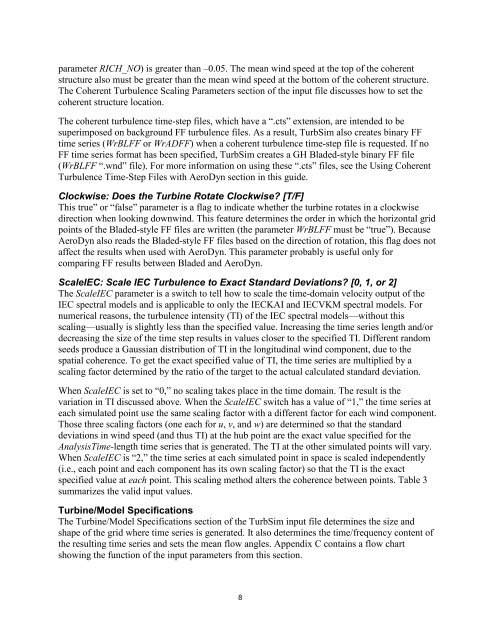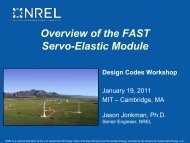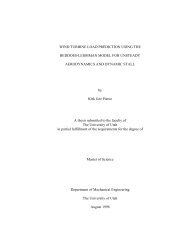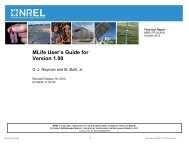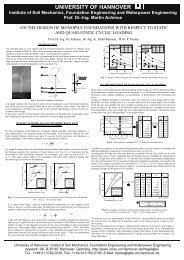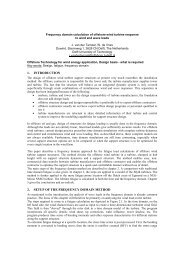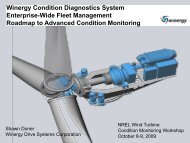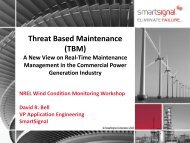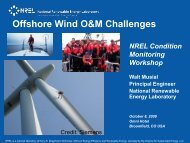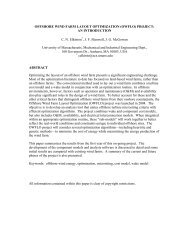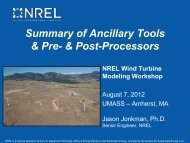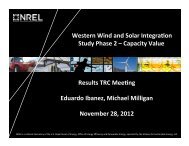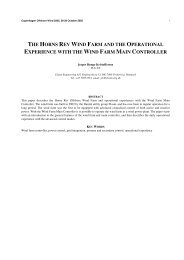TurbSim User's Guide: Version 1.06.00 - NREL
TurbSim User's Guide: Version 1.06.00 - NREL
TurbSim User's Guide: Version 1.06.00 - NREL
You also want an ePaper? Increase the reach of your titles
YUMPU automatically turns print PDFs into web optimized ePapers that Google loves.
parameter RICH_NO) is greater than –0.05. The mean wind speed at the top of the coherentstructure also must be greater than the mean wind speed at the bottom of the coherent structure.The Coherent Turbulence Scaling Parameters section of the input file discusses how to set thecoherent structure location.The coherent turbulence time-step files, which have a “.cts” extension, are intended to besuperimposed on background FF turbulence files. As a result, <strong>TurbSim</strong> also creates binary FFtime series (WrBLFF or WrADFF) when a coherent turbulence time-step file is requested. If noFF time series format has been specified, <strong>TurbSim</strong> creates a GH Bladed-style binary FF file(WrBLFF “.wnd” file). For more information on using these “.cts” files, see the Using CoherentTurbulence Time-Step Files with AeroDyn section in this guide.Clockwise: Does the Turbine Rotate Clockwise? [T/F]This true” or “false” parameter is a flag to indicate whether the turbine rotates in a clockwisedirection when looking downwind. This feature determines the order in which the horizontal gridpoints of the Bladed-style FF files are written (the parameter WrBLFF must be “true”). BecauseAeroDyn also reads the Bladed-style FF files based on the direction of rotation, this flag does notaffect the results when used with AeroDyn. This parameter probably is useful only forcomparing FF results between Bladed and AeroDyn.ScaleIEC: Scale IEC Turbulence to Exact Standard Deviations? [0, 1, or 2]The ScaleIEC parameter is a switch to tell how to scale the time-domain velocity output of theIEC spectral models and is applicable to only the IECKAI and IECVKM spectral models. Fornumerical reasons, the turbulence intensity (TI) of the IEC spectral models—without thisscaling—usually is slightly less than the specified value. Increasing the time series length and/ordecreasing the size of the time step results in values closer to the specified TI. Different randomseeds produce a Gaussian distribution of TI in the longitudinal wind component, due to thespatial coherence. To get the exact specified value of TI, the time series are multiplied by ascaling factor determined by the ratio of the target to the actual calculated standard deviation.When ScaleIEC is set to “0,” no scaling takes place in the time domain. The result is thevariation in TI discussed above. When the ScaleIEC switch has a value of “1,” the time series ateach simulated point use the same scaling factor with a different factor for each wind component.Those three scaling factors (one each for u, v, and w) are determined so that the standarddeviations in wind speed (and thus TI) at the hub point are the exact value specified for theAnalysisTime-length time series that is generated. The TI at the other simulated points will vary.When ScaleIEC is “2,” the time series at each simulated point in space is scaled independently(i.e., each point and each component has its own scaling factor) so that the TI is the exactspecified value at each point. This scaling method alters the coherence between points. Table 3summarizes the valid input values.Turbine/Model SpecificationsThe Turbine/Model Specifications section of the <strong>TurbSim</strong> input file determines the size andshape of the grid where time series is generated. It also determines the time/frequency content ofthe resulting time series and sets the mean flow angles. Appendix C contains a flow chartshowing the function of the input parameters from this section.8


